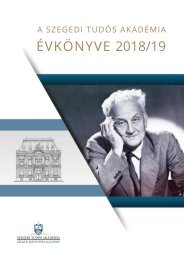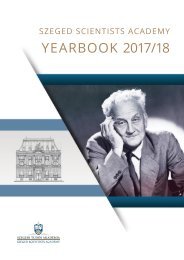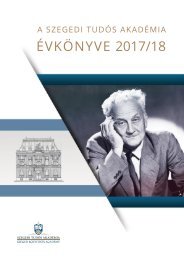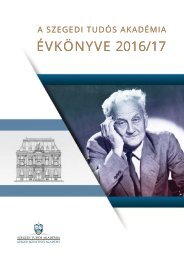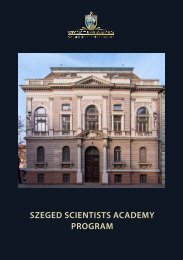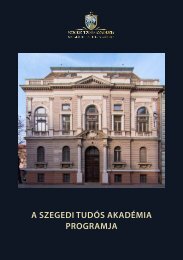SzSA YearBook 2016/17
You also want an ePaper? Increase the reach of your titles
YUMPU automatically turns print PDFs into web optimized ePapers that Google loves.
SZENT-GYÖRGYI MENTORS<br />
JÓZSEF KASZAKI<br />
Institute of Surgical Research,<br />
University of Szeged<br />
Address: Szőkefalvi-Nagy Béla u. 6., H-6720 Szeged, Hungary<br />
E: kaszaki.jozsef@med.u-szeged.hu<br />
T: +36 62/545-672<br />
RESEARCH AREA<br />
Sepsis remains one of the leading causes of death in the<br />
intensive care units which necessitates the development<br />
of new diagnostic tools and novel, more efficient therapeutic<br />
possibilities. The basic problem in sepsis is the discrepancy<br />
between oxygen delivery and oxygen consumption<br />
which can lead to irreversible oxygen extraction deficit<br />
and energy shortage. The cornerstone of acute care should<br />
be to prevent, assess and treat oxygen debt globally. We<br />
propose that causative factors and signs of oxygen deficit<br />
have to be examined together on microcirculatory, cellular<br />
(endothelial) and subcellular (mitochondrial) levels in different<br />
shock-affected organs (e.g. the intestine and lung) by<br />
employing sufficiently long-term, clinically relevant experimental<br />
models. With this theoretical background, the major<br />
goal of our study is to find optimal, clinically applicable manoeuvres<br />
for microcirculatory recruitment and mitochondrial<br />
resuscitation to minimize the energy deficit of organs<br />
during the septic response.<br />
TECHNIQUES AVAILABLE IN THE LAB<br />
Our research laboratories are equipped with instruments<br />
to identify macro- and microcirculatory changes (hemodynamic<br />
computerized data-acquisition and analysis systems,<br />
laser-Doppler flowmetry, fluorescence-based intravital microscopy,<br />
orthogonal polarisation spectral imaging). Fluorescence<br />
confocal laser scanning endomicroscopy technique<br />
offers the possibility of acquiring precise in vivo data<br />
for histological analysis. A high resolution respirometer is<br />
available for examination of mitochondrial function (activities<br />
of the components of electron transport chain) and additional<br />
laboratory facilities (ELISA) to study inflammatory<br />
biomarkers. Animal house and fully-equipped operating<br />
theatres are available for surgical intervention of small (rats)<br />
and larger animals (minipigs).<br />
SELECTED PUBLICATIONS<br />
Érces, D., Nógrády, M., Varga, G., Szűcs, S., Mészáros, A.T.,<br />
Fischer-Szatmári, T., Cao, C., Okada, N., Okada, H., Boros, M.,<br />
Kaszaki, J. (<strong>2016</strong>) Complement C5a inhibition improves late<br />
hemodynamic and inflammatory changes in a rat model of<br />
nonocclusive mesenteric ischemia. Surgery 159: 960-71.<br />
Érces, D., Nógrády, M., Nagy, E., Varga, G., Vass, A., Süveges,<br />
G., Imai, M., Okada, N., Okada, H., Boros, M., Kaszaki, J.<br />
(2013) Complement c5a antagonist treatment improves<br />
the acute circulatory and inflammatory consequences of<br />
experimental cardiac tamponade. Crit Care Med 41: 344-<br />
351.<br />
Boros, M., Ghyczy, M., Érces, D., Varga, G., Tőkés, T., Kupai, K.,<br />
Torday, Cs., Kaszaki, J. (2012) The anti-inflammatory effects<br />
of methane. Crit Care Med 40: 1269-1278.<br />
Kovács, T., Varga, G., Érces, D., Tőkés, T., Tiszlavicz, L.,<br />
Ghyczy, M., Boros, M., Kaszaki, J. (2012) Dietary phosphatidylcholine<br />
supplementation attenuates inflammatory<br />
mucosal damage in a rat model of experimental colitis.<br />
Shock 38: <strong>17</strong>7-185.<br />
Kaszaki, J., Érces, D., Varga, G., Szabó, A., Vécsei, L., Boros, M.<br />
(2012) Kynurenines and intestinal neurotransmission – the<br />
role of N-methyl-D-aspartate receptors. J Neural Transm<br />
119: 211-223.<br />
55







